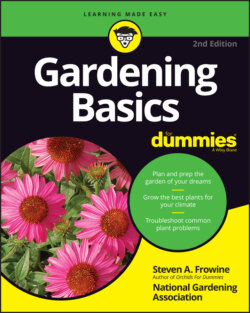Читать книгу Gardening Basics For Dummies - The Editors of the National Gardening Association, Steven A. Frowine - Страница 19
Amazing annuals
ОглавлениеYou may already know what annuals are without realizing that you know! These beauties are the flowers, arrayed in flats and pots, for sale every spring down at the garden center — everything from geraniums to impatiens to marigolds. You bring them home and plunk ’em in the ground, and they get right to work, delivering pretty much continuous color all summer long. When fall comes, they start to slow down (some may even go to seed); cold weather eventually causes them to wither and die. Game over. (That is, unless you live in a frost-free climate; in this case, your “annuals” may become perennials. See the section, “Perennial plants,” later in this chapter for more information.)
© John Wiley & Sons, Inc.
FIGURE 1-2: Flowers come in a wide variety of sizes and shapes.
For the brief time annuals are growing and pumping out flowers, you get a lot of bang for your buck. A great deal of selection and breeding refinements over the years have made these plants totally reliable. They’re full of exuberant energy and hard to kill. Indeed, some of them keep blooming their cheery heads off even when you neglect them. They provide reliable garden color even as perennials cycle in and out of bloom.
Some gardeners have been known to sneer at good old annuals. They’re boring. They’re too perky. They’re “plastic plants.” These folks may or may not have a point, but hey, annuals are hard to beat if you want a colorful garden.
In the end, the main drawback of annuals is economic. You have to buy new ones every spring. If you’re planting a wide area, running out to buy more year in and year out can get expensive. Time may also be an issue for you — you may grow sick and tired of getting down on your hands and knees and replanting. (If you’re getting to that point, consider a longer-term investment, planting perennials.)
You can use annuals
To fill an entire flowerbed (this popular use is why some places call annuals bedding plants)
To add to container displays — in pots, window boxes, patio planter boxes, and more
To fill a hanging basket
To edge a walkway
To insert reliable color in a perennial bed
To decorate a vegetable and herb garden
To cover over or at least distract from a fading spring bulb display
To add summer color to your flower beds when the perennials are done blooming
To fill in places where perennial plants haven’t filled in yet — the added advantage of covering ground so opportunistic weeds can’t move in
If the info you want on annuals isn’t in the upcoming sections, you can get an in-depth look in Chapter 6.
